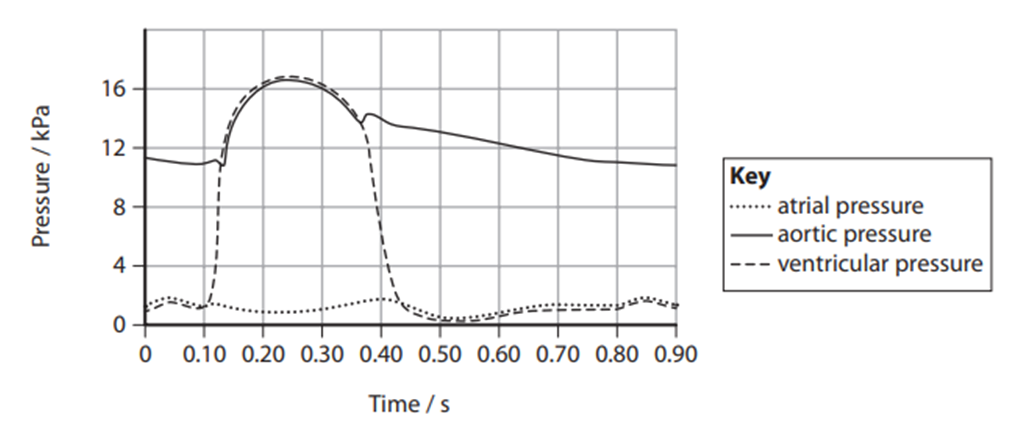1. The graph shows the pressure changes in the left side of the heart during one cardiac cycle.
i) Calculate the heart rate.
ii) During which time period does blood leave the left ventricle?
A) 0.10s to 0.13s
B) 0.10s to 0.37s
C) 0.13s to 0.37s
D) 0.13s to 0.43s
iii) At which time does the valve between the atrium and the ventricle close?
A) 0.10s
B) 0.13s
C) 0.37s
D) 0.43s
2. The diagram shows a section through a mammalian kidney
A) W -cortex X- medulla Y -pelvis
B) W- cortex X- pelvis Y- medulla
C) W-medulla X- pelvis Y- cortex
D) W- medulla X- cortex Y-pelvis
3. (a) The graph shows the frequency of a characteristic found in a population of animals.
Which type of selection would create this pattern?

A) allopatric selection
B) directional selection
C) disruptive selection
D) stabilising selection
4. (a) Mosquitoes have cells with a diploid number (2n) of six.
The diagram shows two cells from a male mosquito at different stages of meiosis(i) Which row of the table shows the stages of meiosis of cells P and Q?
A) P - anaphase II, Q- anaphase I
B) P- metaphase I, Q- prophase I
C) P- prophase I, Q- anaphase II
D)P -prophase II, Q- metaphase II
(ii) Non-disjunction occurred during meiosis I.
Which of the following shows the number of chromosomes in each of the four
sperm cells produced?
A) 4, 3, 3, 2
B) 4, 4, 2, 2
C) 6, 6, 7, 5
D) 7, 7, 5, 5
(b) Down’s syndrome in humans is caused by non-disjunction.
The chance of having a baby with Down’s syndrome increases as the age of the
mother increases.
At age 40, the probability of having a baby with Down’s syndrome is 0.018.
In 2016 the number of women aged 40 in the UK was estimated to be 500000.
The pregnancy rate for women in the UK aged 40 is 14 pregnancies per 1000 women
per year.
Calculate the number of babies with Down’s syndrome that were expected in
2016 in the UK.
Answer:
1 i) .Heart rate = time of cardiac cycle read from the graph and divided into 60
60 ÷ 0.8 = 75 (beats per minute)
ii) C) 0.13s to 0.37s
iii ) A) 0.10s
2. B) W- cortex X- pelvis Y- medulla Learn more: Practice Test on Kidney
3. C) disruptive selection
- directional selection would move the curve in one direction
- stabilising selection would result in one peak
4. (i) C) P- prophase I, Q- anaphase II
ii) B) 4, 4, 2, 2
b) The number of babies with Down’s syndrome
- number of pregnancies calculated (500 000 ÷1000) x 14 = 7 000
- number of babies calculated (1.8 ÷ 100) x 7 000 = 126
- number of babies calculated 14 x 500 = 7000 and then 7000 x 0.018 = 126
Learn more: Human Genetic Disorder
Tags:
Edexcel A Level Biology




